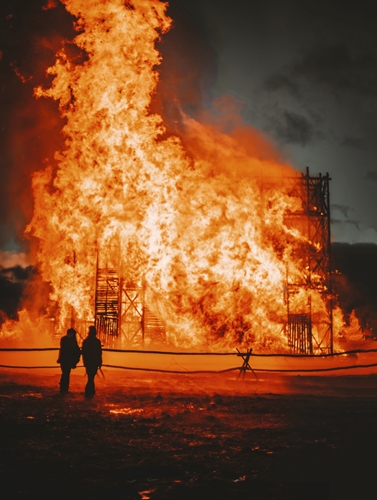It takes as little as 30 seconds for a small lit to becoming a full-blown fire which engulfs the home and threatens the life of the people inside. Statistics indicate that fire causes a significant portion of deaths in disasters and a lot of money in property damage. Recently, fires has become more dangerous and spreads much quicker due to synthetic materials beings used in the house. According to Consumer Safety Director John Drengenberg of Underwriters Laboratories (UL), “Today, with the prevalence of synthetic materials in the home, occupants have roughly 2 to 3 minutes to get out,” Testing by UL has found a home with mostly synthetic-based furnishings can be entirely engulfed in less than 4 minutes. So what happens in a typical house fire? Below is a breakdown of events which may help you to understand how a fire spreads and make sure you escape in time.
The example events start with a kitchen fire, which typically accounts for a share of how house fire started. Oils and flame source makes it a high risk area for a house fire to start.
First 30 seconds:
Within seconds, if a flame occurs on the stove with a pan, the fire easily spreads. With oil and kitchen towel and all kinds of combustibles, the fire can catch on pretty quickly and begin to burn. Putting the fire out now is crucial if possible. Do not move the pan or you risk injuring yourself or spreading the fire and never throw water onto the pan as it would spread the oily flame. Cover pan with a lid to deprive fire of oxygen to put out the flames.
30 seconds to 1 minute:
The fire catches on and gets higher and hotter, lighting up surrounding objects and cabinets and spreading. Smoke and hot air spreads also. If you are breathing in the room, it will burn your air passage and inhaling the deadly gases from the fire and smoke would probably make one pass out with two or three breaths.
1 to 2 minutes
The flame intensifies, smoke and air thickens and spreads and the fire continue to engulf its surroundings. Poisonous gas and smoke builds up and the heat and the smoke spreads out of the kitchen and into hallways and other parts of the house.
2 to 3 minutes
Everything in the kitchen is consumed by the fire and temperature rises. Smoke and poisonous gas continues to thicken and hovers a few feet off the ground. Temperature has reached to a point where the fire can spread by direct contact or materials self-ignites as temperature reaches auto-ignition levels.
3 to 4 minutes
Temperature reaches over 1100 degrees F and flashover happens. Flashover is where everything burst into flames as temperatures can reach up to 1400 degrees F when it happens. Glass shatters and flames shoots out of doorways and windows. Flames pour through into the other rooms as fire spreads and fuel on new elements to burn.
4 to 5 minutes
Flames can be seen from the street as they travel through the house, fire intensifies in other rooms and causes flashovers when temperature reaches to a high point. Structural damage to the house may see some floors collapsing.
So you can see from the minute by minute play of a house fire event that it spreads quickly and it can be deadly if you do not escape in time. If you cannot put it out in the first 30 seconds, chances are you should escape to ensure that you can get to safety in time. Subsequently, never run back inside into a burning house to get belongings as the smoke and poisonous gas can knock you out in an instant or escape routes could be blocked by fire. The best way is to get a store your important documents and valuable belongings in a fireproof safe or a fireproof and waterproof chest. Not only will they help you be protected from fire perils but also have you less worried about your belongings and focus on saving you and your families lives.
Source: This Old House “How a House Fire Spreads”
Post time: Nov-15-2021



